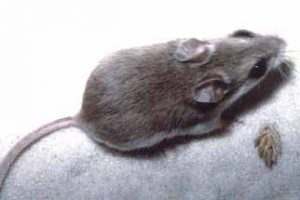Nestled in the sandy dunes of Alabama, you can find a tiny rodent, the Alabama beach mouse. This creature feeds primarily on plants, including sea oats, evening primrose, and seaside pennywort. Occasionally, it consumes insects such as beetles. It only inhabits the sandy areas of the beaches and isn’t compatible with human settlements.
 This mouse has oversized ears and eyes because it’s strictly nocturnal. During the day it rests in its burrow, safe from humans and predators alike. It has a white underbelly and a light-colored saddle across its back and head. Although colors can vary between individuals, the Alabama beach mouse is much paler in color than the standard house mouse. This helps the mouse blend into the beach.
This mouse has oversized ears and eyes because it’s strictly nocturnal. During the day it rests in its burrow, safe from humans and predators alike. It has a white underbelly and a light-colored saddle across its back and head. Although colors can vary between individuals, the Alabama beach mouse is much paler in color than the standard house mouse. This helps the mouse blend into the beach.
Unlike other species of mice, the Alabama beach mouse is helpful. It encourages the growth of plants by redistributing seeds along the coast and dunes. This process is important to help the flora spread and recover from other types of damage. The beach mouse is also an important step for the natural ecosystem, offering food to native predators like the great horned owl.
Why They’re Endangered
Humans are the reason why the Alabama beach mouse is endangered. Residential and commercial developments are quickly destroying the dunes where the rodent lives. Roadways also cut into the available habitats. The little creature doesn’t have the natural space it once enjoyed.
With humans comes another serious threat to the Alabama beach mouse: pets. Domestic cats, in particular, prey on the mouse. Stray cats also pose a risk because they breed quickly and provide a constant threat to the tiny rodent. The population of this unique animal has dropped significantly over a short period of time.
How They’re Protected
The Alabama beach mouse is a preserved species in Bon Secour, a National Wildlife Refuge. There is speculation that its habitat will be expanded to help save the dwindling population. The safety of the mouse has been a concern for several years. In 1998, construction was even called off to help protect the habitat in the Sierra Club v. Babbitt case.
Help protect it by planting native seeds around dune areas to provide more food for the mouse. You can also make sure your garbage is properly disposed of to reduce the chance that competing populations, such as the house mouse, will establish. Controlling outdoor cats is another simple solution that can greatly improve the chances of survival for the Alabama beach mouse.



We just purchased a beach house on Fort Morgan Rd ( hwy 180), about 1 mile west of Kiva Dunes. Sitting app. 150 yds. from the water, behind sand dunes & on a slight incline, we have a beautiful view. One of the few spots where the dunes haven’t been mutilated. We have read a few articles about the endangered beach mouse & want to be good stewards of preserving the mouse. Unfortunately, the 2 lots that makeup the dunes have recently been sold. Construction will begin on 1 lot in app. 2 weeks. The other in 2 months. We have contacted the local US Fish & Wildlife Service. They will monitor construction thruout to be sure that Federal regulations are followed. My wife & I are praying & very upset that these dunes could be destroyed